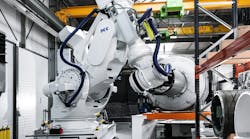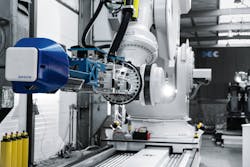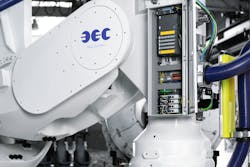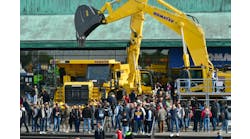Assembling magnetic resonance imaging (MRI) machines requires a high level of precision to be taken, particularly when inserting coils into the magnets used by these machines. Electric actuators from Festo have demonstrated their ability to provide the precision required when used in the grippers of robots employed to build MRI machines.
BEC GmbH – a developer of robotic systems for medical, industrial, and other applications – utilized Festo’s EPCC electric actuators in the gripper system of its 2,300 kg load capacity articulated arm robot. With this robot, BEC’s customer Siemens has been able to improve the assembly of its MRI machines while maintaining build quality.
The Benefits of Electric Actuators
The gripper system mounted to BEC’s articulated arm robot is equipped with 3D scanners, touch-sensitive Airskin sensors, and four supports driven by Festo EPCC electric actuators. Once picked up, the supports help to hold and insert coils – which can weigh up to 1.5 tonnes – into the MRI machine’s magnets.
Hans-Günther Nusseck, project manager at BEC, said the utmost precision is required during this process. “It is vital that the coils do not twist or slip when the gripper picks them up and inserts them into the magnets,” he said. “The tolerance for inserting the coils into the magnets is no more than 0.5 mm.”
Not only must the supports be strong enough to hold the heavy coils, but they also have to do so without causing any damage. Because the force applied by the electric actuators can be adjusted as needed, they can better enable a strong yet gentle grip on the coils.
Use of the Festo electric actuators helped BEC achieve many of its design requirements when developing the gripper system for the Siemens robot. Electric actuators were chosen over pneumatics because of the application’s need for free positioning and the actuators’ ability to provide a strong yet gentle clamp which does not allow the coils to move, Festo explained to Power & Motion. Pneumatics would not be stiff enough to achieve the desired results in this application the company said.
The Festo EPCC electric actuators provide quieter, more precise positioning – a common benefit of electric versus pneumatic technologies. They also offer greater flexibility, a key benefit for this application. As the coil dimensions may vary from one machine build to another, the actuators must be able to adapt to different sizes which is easier to accomplish when using electric actuators.
Additional design features which benefit the actuators’ use in an application such as this include its low internal friction for short positioning times and high dynamic response, and strokes of up to 500 mm.
READ MORE: Robotics Spur Growth in Grippers and Suction Cups
The compact design of the actuator itself and the small space requirement of its drive were critical benefits provided by the Festo electric actuators as well. A compact ball screw drive enables a smaller package size as do the integrated coupling and double bearing. Flexible mounting of the motor in an axial or parallel position also aids space claim and can be changed whenever necessary.
READ MORE: Electric Actuation Mixes Precision and Efficiency
Festo’s CMMT-ST servo drive is mounted on the robot instead of the gripper system reduces space requirements on the gripper and makes it less complicated. The servo drive has a PROFINET Interface for easy integration with existing PLCs used by Siemens while allowing the electric actuator to be controlled with a defined speed and limited force to meet application requirements said Festo.
BEC worked closely with Festo throughout the development process, starting at the design phase with dimensioning of the cylinder as well as support during integration with the customer’s PLC. “We started working with Festo right from the initial phase of the project to make sure that the drives were designed, sized and commissioned efficiently and matched the overall system,” said Nusseck.
Robot Improves Assembly Process
Siemens’ use of the BEC articulated arm robot has made the work of inserting coils safer and more efficient. Human interaction during this portion of the MRI machine build is minimized due to the automation of many process steps.
Sensor technology integrated into the robot’s gripper system allows it to move freely and safely without fear of harming human workers in the area as the sensors can immediately detect and mitigate these interactions. As such, Siemens was able to remove the safety fence around the robot and use its employees in a supervisory role during the coil insertion stage of the assembly process.
Working together with robots in this manner not only helps to keep workers safe but also frees them up to focus on other, more important work which requires their expertise and attention. Meanwhile, the robot can be used for more difficult work for which repeated precision may be required and could be hindered if done by humans.
“It is precisely this human-robot cooperation that we consider to be our unique selling point,” concluded Nusseck.
Watch the below video from Festo to see how the articulated arm robot equipped with the company's electric actuators inserts coils for MRI machines in a safe and precise manner.





